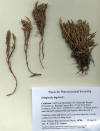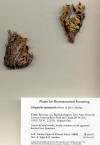|
Selaginella bigelovii Peninsular Ranges, Riverside Co., |
|
|
Selaginella bigelovii Kern Co.: Mill Creek Trail |
Selaginella lepidophylla Brewster Co., TX |
|
Trees and Shrubs of Kern County (Jan 2013, July 2015) Selaginella Not a moss or typical shrub. Low creeping or climbing or erect evergreens with one or two leaf types on the same plant; one type with leaves all similar in size, linear to narrowly lanceolate, overlapping, spirally arranged; the other with leaves arranged in two series, one series larger than the other, the larger positioned laterally, spreading, varying from sword-shaped to round or short with parallel margins (oblong), the smaller appressed or ascending. Reproduction by spores, developing within sexually differentiated sporangia (heterosporous), in successive leaf (sporophyll) axils, collectively a strobilus (strobili plural); megasporangia lobed to ovoid, releasing tetrahedral ovoid or globose megaspores < 1.4 mm diam. that rupture from an emerging gametophyte, which contains the egg; microsporangia reniform to ovoid, releasing tetrahedral microspores, 20–75 µm diam., which produce sperm that swim to fertilize the egg. A genus of ~700 species. Selaginella densa Rydberg 1900, a Rocky Mountain species, used by native Americans for treating “spitting up blood”, to “induce labor” “expel afterbirth,” powdered root given orally to racehorses “to make them hyperactive” (Moerman). Of 34 extracts screened by the NCI prior to 1982 in the genus Selaginella, S. pentagona Spring 1850 was active in WM (Jul 1971) from a sample collected in India, and S. rupestris (Linnaeus 1753) Spring 1838, collected in North Carolina, was active in KB (Aug 1970). Other species reportedly used medicinally and/or screened in antitumor and antibiotic assays (Hilled et al. 2014) contain active biflavonoids (PubMed). Selaginella lepidophylla (Lycopodium lepidophyllum Hooker & Greville 1830) Spring 1840, commonly known as resurrection plant, native to dry limestone pavements and rocky soils in the Chihuahuan Desert of southern U.S. and Mexico, is sold in its natural dehydrated brown state for its back-to-life response to rehydration by quickly turning green; however, it is not easily maintained in a green state; after repeated drying and rehydration it may lose viability to return to life. Additionally, S. bigelovii, which occurs in Kern County, is referred to as “resurrection plant” (MCV2). Three species in Kern County, one of which is treated here as a shrub. Selaginella bigelovii L. Underwood 1898. Bigelow's spike-moss, bushy spike moss. Evergreen plants, or brownish green during dry periods, forming mats on rocks; leafy stems ascending to shortly erect from a ground stem or rhizome, the aerial stems wiry, tough to break by hand; leaves dimorphic, not distinctly ranked, overlapping in spiral arrangement, appressed to stem, persistent, awl-like with minute marginal (0.02–0.08 mm) cilia near the notched or rounded base, 2.2–3.8 mm long, not decurrent, denticulate towards apex from which a shortly hairy bristle extends 0.23–0.75 mm. Strobili quadrangular (characteristic for subgenus Tetragonostachys), 1–1.5 cm long. A California-Baja California species that grows on dry rocky slopes, generally below 6000 ft. “Bushy spike moss mats” (alliance) recognized in MCV2 when “>50% relative cover in the herbaceous layers; shrubs with open to sparse canopy at <5–25% absolute cover.” Type from southern California. Kern Co.: Common in Kern Canyon, especially south-facing rocks along the north side of Kern River. During the early spring—before shrubs and trees leaf out—extensive green masses of Bigelow's spike moss can be seen covering much of the vertical rocks for many miles as reported by Twisselmann. The species occurs in an association with Eriogonum fasciculatum (MCV2). For detailed images of Bigelow's spike-moss, including close-ups of the sporangia, see Armstrong (2005), Wayne's Word, Pteridophyte photos, http://waynesword.palomar.edu/pterido1.htm. Two other Selaginella species occur in Kern County. They differ in their smaller cushionlike habit and by the leaves decurrent at base; S. watsonii L. Underwood 1898 (Watson’s spike moss) distinguished by the shorter leaf bristle (0.25–0.50 mm) compared to the longer bristle of S. asprella Maxon 1920 (bluish spike moss), 0.5–1.4 mm in length; the latter also identified by stems “readily fragmenting” (Valdespino in FNA 1993).
|
|
|
Wangm JZ, Li J, Zhao P, Ma WT, Feng XH, Chen KL. 2015. Antitumor activities of ethyl acetate extracts from Selaginella doederleinii Hieron in vitro and in vivo and its possible mechanism. Evid Based Complement Alternat Med. 2015. Biflavonoids main active agents. Hilled, J., Woerdenbagd H. J., Beninab, M, Mehterove N,, Tonevab V., Fernief A.R., and Mueller-Roeber B. 2014. Natural products from resurrection plants: Potential for medical applications. In: From Plants to Pharmacy Shelf: Recent Trends in Leads Finding and Bioproduction, Ed. M. I. Georgiev. Biotechnology Advances 32 (6), Pp 1091–1101.
Li J, Lei X, Chen
KL. 2014.
Pampurova
S, Van Dijck P. 2014. The desiccation tolerant secrets of
Selaginella lepidophylla: what we have learned so
far?
Rizk YS, Fischer A, Cunha Mde C, Rodrigues PO, Marques MC, Matos Mde F, Kadri MC, Carollo CA, Arruda CC. 2015. In vitro activity of the hydroethanolic extract and biflavonoids isolated from Selaginella sellowii on Leishmania (Leishmania) amazonensis. Mem Inst Oswaldo Cruz. 2014 Dec;109(8):1050–6.
Zou H, Xu KP, Li
FS, Zou ZX, Liu R, Liu RH, Li J, Tan LH, Tan GS. 2014. Unciflavones A-F,
six novel flavonoids from Selaginella uncinata (Desv.) Spring.
Fitoterapia 99: 328–33.
|
|


